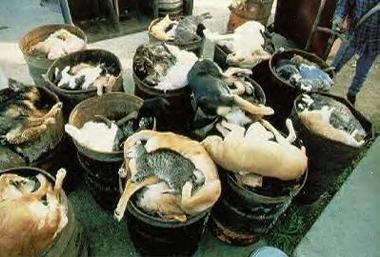~~~~~~~~~~~~~~~~~~~~~~~~~~~~~~~~~~~~~~
Pet food manufacturer Party Animal voluntarily recalled two variants of their Cocolicious brand dog food after it was determined to be contaminated with pentobarbital, a pet euthanasia drug.
- The disgusting truth is that the bodies of pets who have been put to sleep are sold to pet food companies to be used as protein in their ingredients.
- Aside from the problematic issue of cannibalism itself, keep in mind that euthanized pets often have tumors, cancers, and other diseases. It all goes into the big pot of ingredients.
- The drug itself is toxic if ingested in small amounts over a long period of time.
- When amounts are small they go unnoticed but they are damaging to the pet's health in the long run.
- In this case there was so much of it in their food that pets got very sick and vets alerted owners of the presence of Pentobarbital in their dog's food.
VIDEO: Former AAFCO (Association of American Feed Control Officials) President admits pet food may contain pets.
Even the most prestigious pet brands may contain ingredients that are pre-manufactured in China, a country that is notorious for its lower safety standards.
2007: Thousands of pets got sick and died from the effects of an ingredient imported from China by top quality American pet food companies. https://en.wikipedia.org/wiki/2007_pet_food_recalls
2016: FDA: Jerky treats (mostly from China) sickened 6,200 dogs, killed 1,140 The illness reports also involved 26 cats and three people. http://www.petfoodindustry.com/articles/5822-fda-update-jerky-treats-sickened-6200-dogs-killed-1140
2015: At least 4000 dogs killed by PURINA BENEFUL DRY FOOD toxic ingredients (in moldy grains), lawsuit claims
Please feed your pets home made food. There are websites that will provide you with recipes. Cats are easy to feed. Just buy cans of tuna or sardines. They are not more expensive than pet food and you are ensuring a better health and longer life for your pet, on top of saving in vet bills. Give cats little bits of hard boiled egg yolk, and cat grass to help their digestion.
Here is just one example of many pet foods contaminated with one thing or another. On this page see link to a veterinary website listing all pet foods that have been recalled in the past year. You'll be surprised to find many of the top quality brands included.
Excerpt from the Party Animal Pet Food webpage. This food was found to contain excessive amounts of the euthanasia drug Pentobarbital. It is possible that the company imported ingredients without knowing their actual contents.

HAND CRAFTED IN SMALL BATCHES & MADE WITH LOVE!
In 2006, we embarked on a mission to create the most scrumptious & healthiest pet food from our kitchen for our furry children. We had no business plan, just a passion to provide the healthiest meal possible for our pets to enjoy.Today, Party Animal™ continues to develop products that are never compromising. We use the best ingredients available, such as: organic and wholesome protein sources, organic oils, organic fruits and organic vegetables. All of our products are complete and balanced for all breeds and life stages with added vitamins and minerals to nourish your furry child's body from the inside out. If your furry child approves of our product, please spread the word everywhere from Facebook, to Twitter, to Instagram, to Yappy Hour, or Happy Hour!
Thank you for your continued support of Party Animal™!
PET HEALTH NEWS - Pet food manufacturer Party Animal voluntarily recalled two variants of their Cocolicious brand dog food after it was determined to be contaminated with pentobarbital, a pet euthanasia drug.
Continue reading this, articles documenting the use of euthanized pets in pet food, and watch VIDEO of pet food manufacturing company employee dumping dead pets into containers for processing.
The implicated products are: Cocolicious Beef & Turkey dog food (Lot #0136E152 04, best by July 2019) and Cocolicious Chicken & Beef dog food (Lot #0134E152 37, best by August 2019).
In a public statement released to the FDA.gov, the company said, “the safety of pets is and always will be our first priority. We sincerely regret the reports of the discomfort experienced by the pet who consumed this food.”
Party Animal was first made aware of these potentially toxic batches after a retailer in Texas reported health abnormalities in a pet after eating samples of the aforementioned products. This was on April 13. Cans of the Cocolicious brand were sent to an independent testing lab where it was proven that the contents did indeed contain pentobarbital.
This drug, in large amounts, is used to put animals to sleep. Smaller doses can cause side-effects such as drowsiness, dizziness, loss of balance, or nausea.
After receiving the results, Party Animal immediately tracked down the lot numbers and found that these batches were manufactured and distributed in 2015.
The company then contacted the two probable retailers who had sold the customer the food and asked them to isolate the remaining cans from these lots.
In the same public statement, Party Animal requested all pet owners who have cans with either lot number in their possession to return them to the place of purchase. Owners will receive a full refund.
Retailers are requested to send all contaminated cans back to the company where more independent testing will be conducted. “Out of an abundance of caution, we are retrieving the remainder of these two lots nationwide.
We are working with our distributors and retailers to determine if any additional beef-flavored products manufactured during this 2015 production period remain on shelves and, if so, to retrieve them from shelves, immediately, as well,” the company further stated in their recall notice.
The company ended by stating that they have submitted all their recent batches of dog food for testing for pentobarbital.
Other reports of dog food contamination
Last February, Evanger’s Dog & Cat voluntarily recalled their Hunk of Beef products after they suspected these items to contain pentobarbital. The company officially recalled cans manufactured between June 6 and June 13 of 2016 with the following lot numbers: 1816E03HB, 1816E04HB, 1816E06HB, 1816E07HB, and 1816E13HB.
All of these lots had an expiration date of June 2020. According to the company’s statement, five dogs were taken ill from eating their Hunk of Beef brand. One dog had died.
Evanger’s widened their recall recently, including their Against the Grain’s Pulled Beef and their Braised Beef Chunks brands. Since the initial recall, Evanger’s has severed ties with its supplier after four decades.
Holly Sheer, President and Owner of Evanger’s told USAToday.com, “in spite of this voluntary, expanded recall, our entire Evanger’s family remains very optimistic for our strong future and serving our customers to the very best of our abilities.”
Protecting your pets and your family
Owning a pet is a beautiful experience. Whatever the species, pets provide comfort and offer companionship. We should repay this kindness by ensuring their safety. An article on the Centers for Disease Control and Prevention website lists a few tips when purchasing, serving, and storing pet food:
- Purchasing – Always go to a trusted retailer. While this story does suggest that well-known brands are not invulnerable to contamination, it is still important to choose brands (ideally natural ones) that follow strict guidelines and safety policies in manufacturing their food.
- Serving – Always wash your hands before and after handling pet foods and treats. This is the simplest way to prevent illness. The CDC recommends washing hands for at least 20 seconds. As much as possible, avoid washing pet food and water dishes in the kitchen sink to prevent cross-contamination.
- Storing – Avoid storing pet food in the same area where human food is stored. Pet food should also be kept in a cool, dry placed under 80 degrees Fahrenheit.
Source
Euthanized pets at a rendering plant
Abandoned, abused, unwanted. Many of these animals come from shelters. Others have been put to sleep due to disease.
Abandoned, abused, unwanted. Many of these animals come from shelters. Others have been put to sleep due to disease.
VIDEO
What's REALLY In Your Pet's FOOD??
See how dead pets are processed into pet food
How do dead pets get into pet food?
DOGS NATURALLY MAGAZINE - The way these dead animals wind up in your pet’s food is through a process known as rendering. The industry group behind the rendering plants in this country is the National Renderers Association, or NRA, and they’ve helpfully posted a quite lengthy book on theirWeb site called Essential Rendering, which you can download.
According to this book, these are the products of the rendering process: meat and bone meal, meat meal, poultry meal, hydrolyzed feather meal, blood meal, fish meal, animal digest, and animal fats. It’s important to know the significance of the terms “meal” and “animal.” Meal is a product of rendering; once thecollection ofanimal scraps and whole dead animals is collected, the entire mess is heated, has the moisture and fat removed, and what is left is meal. So you can make a meal that is poultry, or fish, or blood, or what’s referred to as “meat.”
Why meat? Because if you don’t know exactly what’s in there, you can’t call it beef, or poultry, or fish. Meat means anything that was alive, whether it’s the cow at the stockyard that’s so diseased it can’t stand up or the possum on the side of the road or the zebra that died at the zoo-or your pet, recently euthanized at your veterinarian’s office. Meat means it was a mammal that was until recently (we hope) alive. Same with “animal” fat, so-called because trying to determine how many animals and of which species went into that fat is impossible. If you see the words “animal” or “meat” on a product (even human food), put it back on the shelf and back away slowly. (By the way, rendered products go into your cosmetics, soap, and even your toothpaste; just FYI.)
So where do these “meats” and animals come from? The February 2009 NRA “Buyer’s Guide to Rendered Fats” says that renderers “process a variety of raw materials from various sources,” including these: packing house by-products, such as organ fats, offal, bones, and blood; boning house material that consists of bones and meat trimmings; meat market trimmings, including adipose and intermuscular fats, bone, cartilage, and meat trimmings; restaurant greases and recovered cooking oils (these are supposed to be processed and stored separately); and, yes, fallen animals.
It’s the “fallen animals” part that seems extraordinarily open to interpretation, and again, note the use of the word “animals,” not specific species, and “fallen,” which doesn’t exactly say how they fell.
In fact, it’s worth knowing that there are two categories of renderers, those actually attached to meat packing or food production facilities, and the ones known as independent renderers.
The independents are the folks who pick up dead animals and their scraps, whether they’re from yourlocalsupermarket or restaurant or from yourlocalanimal shelter or the side of the road.
Then those truckloads are delivered to rendering plants, where the whole mess is boiled down into the euphemistically named “meat and bone meal” that winds up in your pet’s food.
And that also explains why your pet’s food can contain such things as bits of ID tags,flea collars, antibiotic tags from livestock, and even plastic.
The “Buyer’s Guide to Rendered Fats” also notes that almost all tallow (a fat byproduct of the rendering process) “contains polyethylene (PE), which is a foreign material in tallow, to some degree. It finds its way into the rendering plant as meat wrappers mixed in with the raw material. Most of the polyethylene wrappers used by the meat industry are of low density type that will melt at lower temperatures and stay soluble in the tallow.” Well, that’s certainly good to know; at least it’ll be melted before your pet eats it or you brush your teeth with it.
But how do meat wrappers get into your pet’s food? When the truck heading to the rendering plant dumps its load of meat rejects from yourlocalsupermarket, including trimmings, refuse, offal (as bad as it sounds), and outdatedpackagesof meat, they don’t bother to remove the packaging. Think about that for a moment: The Styrofoam trays and the plastic wrap go right into the cooker with everything else.
(In an odd bit of irony, Mars produces not only Cesardog foodbut a product called Sheba, for cats. Sheba touts itself on itsWeb siteas being a truly “premium” food for pampered pets, with pieces of actual chicken and fish “never sullied by the addition of artificial flavors or by-products.” Yet when you look at the labels on the Cesar line ofdog foods, you’ll see that most if not all of them are made with those same by-products. Which is it, Mars? Are your pet foods “sullied” by by-products, or not?)
Unfortunately, the road kill, plastic wrap, andflea collarsare probably not the worst things you’ll find in your pet food: You may also find sodium pentobarbital, the drug used to euthanize animals in vets’ offices and shelters nationwide. A class-action lawsuit filed last year in U.S. District Court, Miami, on behalf of pet owners against pet food companies, includes references to euthanized animals, and the pentobarbital that killed them, being in pet food. You can read the lawsuit and exhibits here: http://www.mflegal.com/petfoodlawsuit.
One of the exhibits in the lawsuit is a report from the FDA’s Center for Veterinary Medicine on pentobarbital residues in drydog food, which shows that numerous brands contained the euthanization drug. (By the way, access the report from the lawsuit’sWeb site; if you try it through the FDA site, you’ll find the report has mysteriously disappeared.) The FDA’s CVM lists ‘rendered ingredients’ in those foods: animal digest, animal fat, beef and bone meal, beef tallow, and meat and bone meal.
And it says this: “Because in addition to producing anesthesia, pentobarbital is routinely used to euthanize animals, the most likely way it could get intodog foodwould be in rendered animal products. Rendered products come from a process that converts animal tissues to feed ingredients.Pentobarbital seems to be able to survive the rendering process[emphasis mine].”
The American Journal of Veterinary Research in January 2004 published a study which failed to find dog or cat DNA in the samples of pet food it tested but noted that the higher the ranking of “animal fat” on the ingredient list, the greater the likelihood that the sample would contain pentobarbital. (By the way, animal fat is that pungent smell you notice when you open a new bag of dry dog or cat food; the kibble is sprayed with it to make it palatable to your pet.) But Ann N. Martin, in her excellent bookFood Pets Die For, quotes a researcher who told her that heating destroys DNA-and rendering, of course, is heating, taken to the extreme. They found no dog or cat DNA in the same samples that did produce pentobarbital? No surprise there.
A story in theLos Angeles Timesin 2002 said this: “By far the bulk of rendered material comes from slaughterhouses. But some plants also mix in road kill, the trimmings from supermarket delis, dead farm animals and euthanized pets from shelters. Los Angeles city and county shelters send more than 120,000 dead dogs and cats to be rendered in a typical year.”
In fact, in a particularly unholy alliance, the major pet food producers have partnered with animal shelters all over the country. The shelters get free food-most often Iams and Hill’s-and the producers get to plaster their advertising all over the shelters and come out smelling like roses.
Too bad that when you follow the whole thing through, what you get is this: shelters send their euthanized animals to renderers, who turn the animals into “ingredients” which are sold to the pet food companies to become pet food, which is then shipped to the shelters to feed new animals, which will likely be euthanized . . .
The Pet Food Institute, of course, the organization overseeing exactly what it sounds like, insists there are no pets in their members’ products.
The Pet Food Institute is in Washington, D.C. (surprise!), where they can do their best work to influence legislation, and has two categories of membership. The “active” members are all the major pet food producers, including those whose products you may be buying. “Affiliate” members include renderers such as Darling International (the largest renderer in the country, with facilities in numerous states, even this one) and Valley Proteins. (“Protein” is code for “rendered animals.”)
But take a look at this short short video clip of a reporter speaking with the president of the Association of American Feed Control Officials, the folks who, along with the PFI, decide what goes into pet food. When asked by a reporter if there’s any way to tell from a label whether a product contains dogs or cats, Hersh Pendell says if the label says meat and bone meal, there’s no way to tell whether it contains “cattle or sheep or horse, or Fluffy . . .” (Pendell is, not surprisingly, no longer the president of the PFI.)
On the AAFCO Web site, in a list of questions and answers about pet food, you’ll find a question about whether parts from “sick, dying, or dead” animals are used. Their answer? “Animal by-products which may include materials from animals which died by means other than slaughter are explicitly defined as adulterated unless the materials are rendered in compliance with animal health and protein product regulations to destroy any potential microorganisms which may be in the products.
The processes used are deemed to be adequate to control risk of disease.” In other words, sure, we use diseased or euthanized animals, even road kill, but rendered ingredients are fine, and of course they’re safe, even though they may have come from animals sick with all sorts of terrible diseases, including cancers and neurological illnesses, and they may even contain the actual drug used to euthanize animals.
So who’s looking out for you and your pets? Well, it’s not the industry organizations, and it’s not the pet food manufacturers, and it’s certainly not the FDA. It’s you. And if you’re armed with the terms you need to know and watch out for, your job will be much easier. Remember that any ingredient called by-product, meal, tallow, animal fat, or grease is almost certainly a rendered product, which admittedly limits your options somewhat. I recommend that you either buy foods referred to as’super-premium’![]() or organic
or organic![]() , which usually won’t include rendered products, or that you read every label very carefully and avoid those products you’re not sure of.
, which usually won’t include rendered products, or that you read every label very carefully and avoid those products you’re not sure of.
My other suggestion, and this isn’t as hard as it sounds, is to make your own pet food.
It’s very simple to throw a whole chicken in a crockpot, then remove the skin and bones and mix the cooked meat with cooked barley (which my own dog loves) or another whole grain and some veggies. As persnickety as even my Harry is, he adores the food I’ve been making for him most of his life, and he’s often taken for a puppy by strangers, even though he’s nearly seven years old. There are any number of books (including Martin’s) and Web sites available which will give you simple, easy-to-make recipes for pet food-and, as I found, you’ll be happier knowing you’re not subjecting your fur kids to harmful, even potentially deadly, ingredients
It’s very simple to throw a whole chicken in a crockpot, then remove the skin and bones and mix the cooked meat with cooked barley (which my own dog loves) or another whole grain and some veggies. As persnickety as even my Harry is, he adores the food I’ve been making for him most of his life, and he’s often taken for a puppy by strangers, even though he’s nearly seven years old. There are any number of books (including Martin’s) and Web sites available which will give you simple, easy-to-make recipes for pet food-and, as I found, you’ll be happier knowing you’re not subjecting your fur kids to harmful, even potentially deadly, ingredients
Source
EPA Document Proves Euthanized Dogs and Cats are Rendered
One more confirmation to the horror many of us have suspected for years; an EPA document clearly states Rendering Facilities “obtain animal by-product materials” from “animal shelters.” Along with another EPA report, the evidence is mounting; current pet food regulations must be changed.
No pet lover in their right mind would ever wish to feed their dog or cat ground up dog and cat. But that is exactly what is happening.
Deep within the EPA document ‘Emissions Factors and Policy Applications Center, Chapter 9: Food and Agricultural Industries, Section 9.5 Introduction to Animal & Meat Products Preparation’ is the section 9.5.3 Meat Rendering Plants. The truth is crystal clear.
“Meat rendering plants process animal by-product materials for the production of tallow, grease, and high-protein meat and bone meal. Plants that operate in conjunction with animal slaughterhouses or poultry processing plants are called integrated rendering plants. Plants that collect their raw materials from a variety of offsite sources are called independent rendering plants. Independent plants obtain animal by-product materials, including grease, blood, feathers, offal, and entire animal carcasses, from the following sources: butcher shops, supermarkets, restaurants, fast-food chains, poultry processors, slaughterhouses, farms, ranches, feedlots, and animal shelters.”
Since the first public awareness of rendered (cooked) euthanized dogs and cats, the Pet Food Industry has claimed this type of rendered material is not used in pet foods. However, to present day, there is no evidence or regulation to support their claim.
This is simply the most inexcusable horror. If no pet food or pet treat contained ingredients sourced from rendered dogs and cats, pet food regulations would clearly state such ingredients are forbidden. They do not.
In fact, existing pet food ingredient definitions and pet food regulations do NOT allow for pet foods to clearly separate themselves (those using human grade meat from those using rendered euthanized animals). There is no regulatory means for a pet food that does not use ingredients sourced from rendered dogs and cats from pet foods that do use ingredients sourced from rendered dogs and cats.
Why? The only answer could be is those that do use ingredients sourced from rendered dogs and cats don’t want us to know who they are.
Regardless of quality of ingredients (regardless if ingredients are sourced from rendered dogs and cats), existing regulations state the pet food labels must all look the same. Same ‘Premium’ or ‘Healthy’ claim, same ‘AAFCO Nutritionally Balanced’. Again, regardless if the pet food includes meat from the same quality of meat you purchase at the grocery or if the pet food includes meat from rendered dogs and cats, according to existing regulations the pet food label and advertising must all look and appear to be the same. Ridiculous.
The only way pet owners can possibly avoid using pet foods that include ingredients sourced from rendered dogs and cats is to read ingredients. According to FDA testing, “there appear to be associations between rendered or hydrolyzed ingredients and the presence of pentobarbital in dog food.” (Pentobarbital is the drug used to euthanize dogs and cats.) The FDA found the common pet food ingredients Animal Fat, Meat and Bone meal, Beef and Bone meal, and Animal Digest “could include euthanized animals.”
Because existing pet food regulations and existing pet food ingredient definitions do not allow for grade or quality statements of ingredients, because there is a slew of evidence that clearly shows euthanized dogs and cats are rendered present day, conscientious pet owners must avoid any pet food and treat that contain the ingredients Animal Fat, Meat and Bone meal, Beef and Bone meal, and Animal Digest.
Until pet food regulations provide conscientious pet owners with a classification of ‘human grade ingredients’, we have no option but to assume any dog food, cat food, or pet treat that contains Animal Fat, Meat and Bone meal, Beef and Bone meal, and/or Animal Digest does indeed include rendered dogs and cats.
Pet owners MUST be provided with clear and documented evidence to grade or quality of ingredients.
In the EPA document “Development Document for the Proposed Effluent Limitations Guidelines and Standards for the Meat and Poultry Products Industry Point Source Category (40 CFR 432)”…
Page 155
“Regulations promulgated under the authority of Poultry Products Inspection Act are more specific and require that all carcasses, organs, or other parts of carcasses be condemned, if it is determined on the basis of a sound statistical sample that they are adulterated because of the presence of any biological residue (9 CFR 381.80). Biological residue is defined as any substance, including metabolites, remaining in poultry at the time of slaughter or in any of its tissues after slaughter, as the result of treatment or exposure of the live poultry to a pesticide, organic compound, metallic or inorganic compound, hormone, hormone-like substance, growth promoter, antibiotic, anthelmintic, tranquilizer, or other agent that leaves a residue (9 CFR 381.1).”
Condemned animal carcasses are currently allowed (by FDA compliance policy) to be rendered into pet food and pet treats. They become the pet food ingredients by-product meal, poultry by-product meal, chicken by-product meal, beef by-product meal, meat and bone meal, beef and bone meal, animal fat, and/or animal digest.
Page 184
“When the solids are disposed of by rendering, the use of organic polymers is preferred to avoid high aluminum or iron concentrations in the rendered product produced.”
As with some pet food manufacturers, not all renderers process horrendous ingredients into pet food ingredients…
Page 221
“EPA also observed during site visits that some independent renderers reject raw materials that have (1) a pH below 4 SU (with 3 SU being a general cut-off), (2) ferric chloride due to its corrosive nature, and (3) other contamination (e.g., pesticides).”
But…thanks to existing AAFCO regulations (American Association of Feed Control Officials is responsible for all pet food ingredient definitions and for the lack of pet food ingredient grade classification), pet owners are not provided with information of which pet foods use by-products that include contaminants or which pet foods use by-products that are human grade quality internal organs (considered by-product by definition).
So, fine. AAFCO and FDA, you leave us no option. Because you clearly consider the profits of big business to be of more importance than the health of our pets, we have no option but to avoid all pet foods and treats that include any by-product, animal fat, meat and bone meal, beef and bone meal, and animal digest ingredient.
Because AAFCO regulations do not provide a clear definition of human grade ingredients, because FDA doesn’t enforce existing Federal laws that should prevent anything less than human grade ingredients into pet food, both organizations further the great divide between pet owners and trust of pet food.
Source
More articles on PET HEALTH on this blog
FOR MORE INFORMATION on pet food recalls, please visit AVMA - American Veterinary Medical Foundation:










No comments:
Post a Comment
Thank you for visiting my blog. Your comments are always appreciated, but please do not include links.